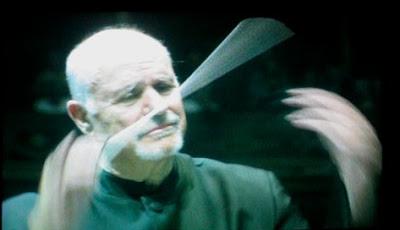by Paul J. Pelkonen

David Zinman in motion. Photo courtesy davidzinman.org.
This week at the New York Philharmonic was supposed to be a summit of young artists. Canadian pianist Jan Lisiecki was scheduled to make his New York debut with the Schumann Piano Concerto. And on the podium: Daniel Harding, the imaginative young British conductor. Music lovers looked forward to hearing his interpretations of two Sibelius symphonies: the Third and Seventh.However, Mr. Harding cancelled due to illness. His place was taken by David Zinman, the veteran American conductor (and Brooklyn native) who last appeared with the orchestra for The Modern Beethoven, a two-week survey of that composer's instrumental symphonies in March of this year. From the chugging cello-driven opening of the Sibelius Third, the audience at Friday morning's 11am concert knew that they, and the orchestra were in the hands of an expert.
Mr. Zinman's calling card is clarity, bringing out unusual textures from the depths of a well-known score so listeners sometimes walk out having heard a work in a different way. This approach was admirably suited to the Sibelius Third, a lean, thirsty symphony in which the Finnish composer eschewed nationalism and narrative for pure music and an economy of style that would serve as his second musical legacy.
The three movements had their share of individual pleasures. The first tease of the closing theme of the finale (played in the brass at the end of the first movement) thrilled the listener. Delicate woodwind writing in the slow central movement provided opportunity for the Philharmonic soloists. Their lines intertwined and cavorted over an aphoristic rhythm in the low strings. The last movement was electric, gathering power as that motto theme finally revealed itself in all its magnificent detail.
Mr. Lisiecki is just 17, a tall, blond figure from Alberta, Canada. He has the lanky build and long fingers that make piano teachers say the most encouraging things--and the good fortune to find himself on a new Deutsche Grammophon album of Mozart concertos. Here, he played the Schumann Concerto with a welcome delicacy, tracing out the nimble, silvery solo part against Mr. Zinman's carefully controlled accompaniment.
The long first movement emerged with its architecture clearly delineated, as pianist, conductor and orchestra found themselves in the unusual position (for a Romantic concerto) of working together toward a common musical goal. The second allowed Mr. Lisiecki to explore Schumann's lyricism with delicate runs against the orchestral fabric. The real thrills came in the final Allegro vivace, as Mr. Lisiecki used the central staccato rhythm to launch a dazzling display. This is a young man to watch--and more importantly, listen to.
Sibelius' Seventh Symphony is his last, a cryptic single span lasting twenty minutes. Its unique structure and history (being the penultimate work published by Sibelius at the age of 62, 28 years before his death) has led to many musicological questions.
- Was there a lost Eighth that followed?
- What was the reason for the composer's self-imposed silence?
- Why is it only one movement?
- Does it have four movements built into its fabric?
- Does it in fact have eleven, the number of tempo shifts within the work?

